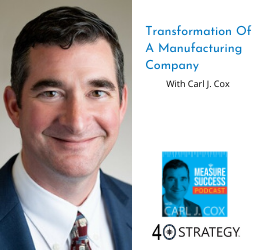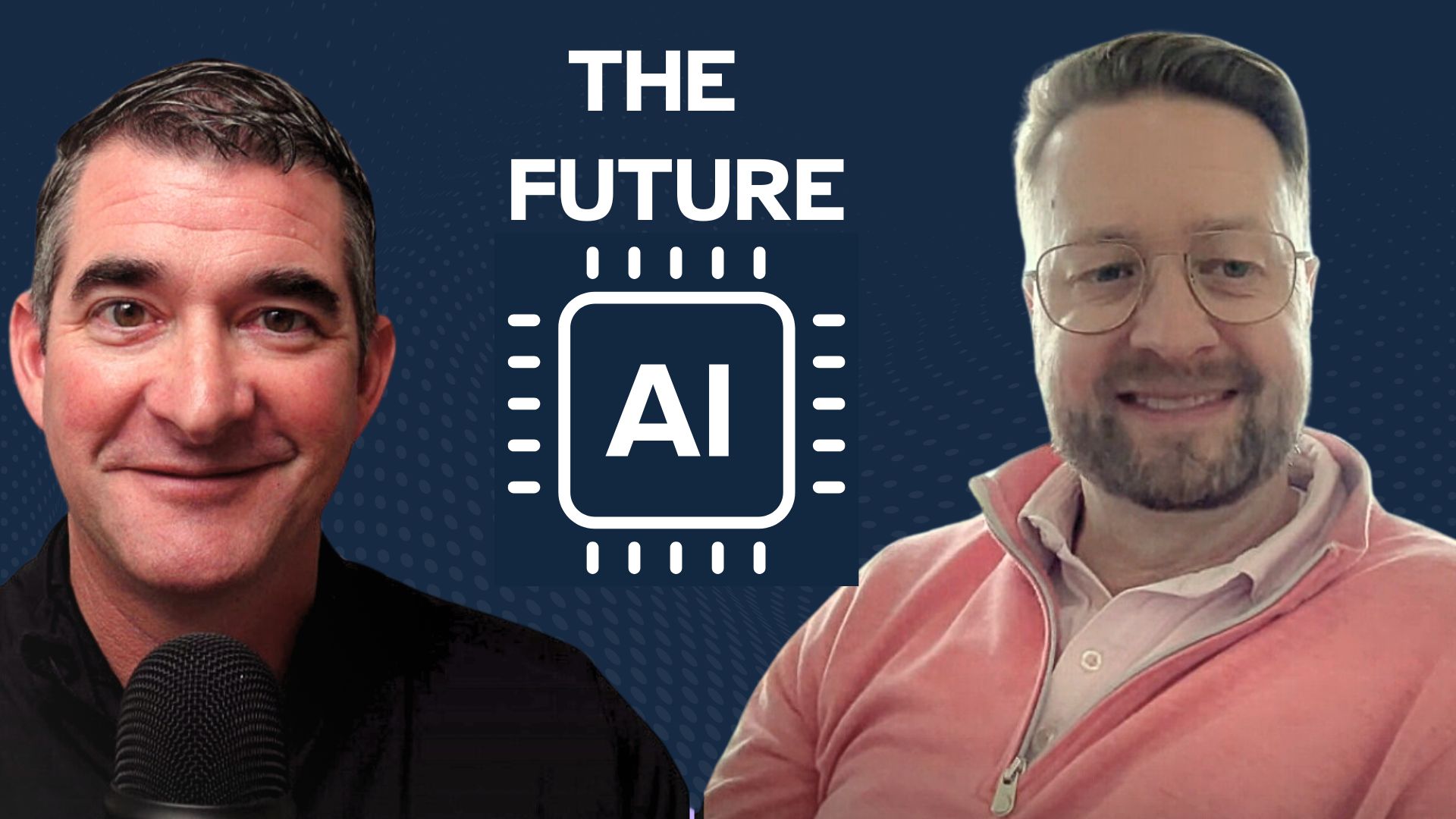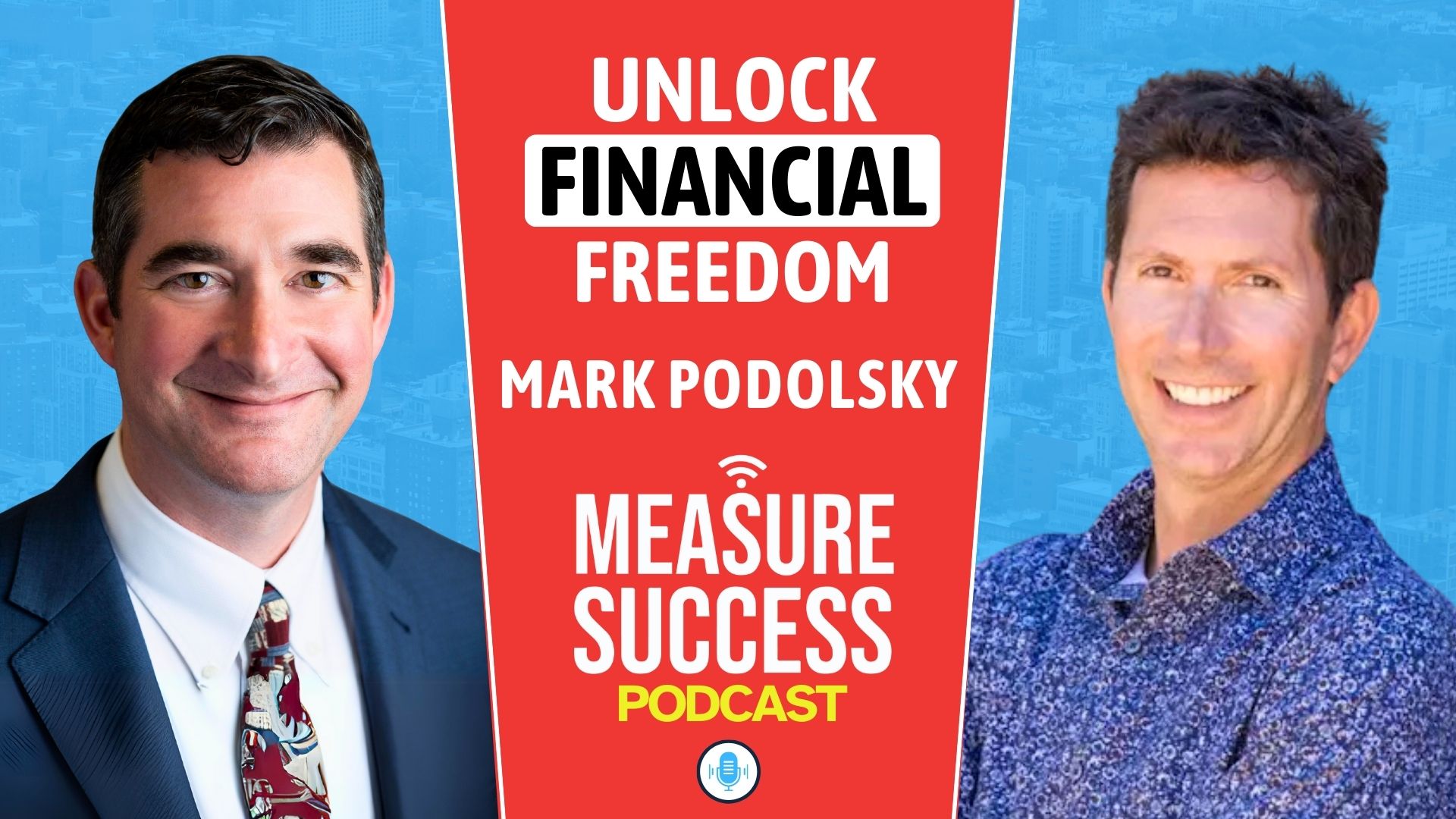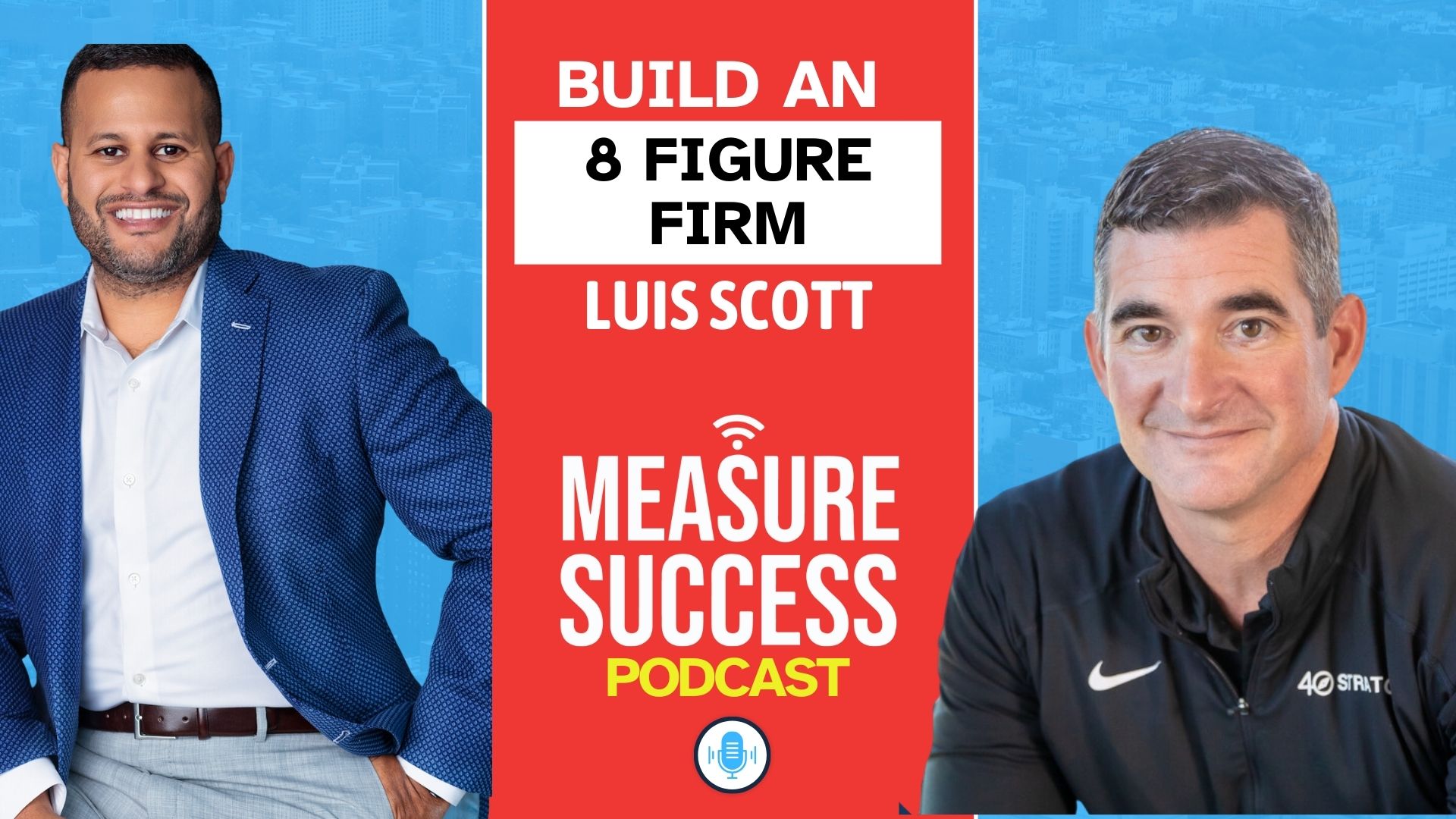 Carl J. Cox is the CEO of 40 Strategy, a strategic planning consulting firm where he helps organizations from around the world navigate their internal practices. With over 15 years of executive leadership experience, he remains a trusted advisor to many high-level organizations due to his proven practices in facilitation, navigation, and scenario planning.
Carl J. Cox is the CEO of 40 Strategy, a strategic planning consulting firm where he helps organizations from around the world navigate their internal practices. With over 15 years of executive leadership experience, he remains a trusted advisor to many high-level organizations due to his proven practices in facilitation, navigation, and scenario planning.Here’s a glimpse of what you’ll learn:
- What are the symptoms of a company stuck in the status quo?
- Carl J. Cox explains his seven-part framework for planning a strategy
- The step that most companies miss—and how it can derail your plan
- Why only 20% of strategic initiatives start on time
- How do you build a timeframe for achieving goals that actually works?
- Moving the needle: the three elements that need to come together to move forward
- Carl J. Cox talks about the big moments that follow once you shift your focus
- Examples of reverse engineering a process and why the details are so important
In this episode…
Have you ever wondered why so many businesses fail to reach their goals? At this point, you know that the difference between success and failure isn’t just luck. So, what if there was a better way to plan a strategy that would increase your likelihood of success and keep you from getting off track?
In this episode of the Measure Success Podcast, Carl J. Cox, CEO of 40 Strategy, sits down with Dr. Jeremy Weisz of Rise25 to talk about applying his seven-part framework to move a manufacturing company beyond the status quo. Carl J. Cox takes us through the first steps of mapping out a plan and explains some of the surprising places where most companies get sidelined. He also shares what exactly moves the needle and why the science of cause and effect is such an essential part of change.
Resources Mentioned in this episode
- 40 Strategy
- Contact 40 Strategy
- Carl J. Cox on LinkedIn
- Dr. Jeremy Weisz on LinkedIn
- Rise25
- Business Success Consulting Group
- Adi Klevit on LinkedIn
Sponsor for this episode…
This episode is sponsored by 40 Strategy.
40 Strategy provides strategic planning and consulting to help organizations realize and achieve their dreams by creating and measuring KPIs for success.
Unfortunately, most organizations only spend 2% of their time—or about 40 hours per year—on building an effective strategy.
Increasing the success of those 40 hours is what 40 Strategy does because your success is their passion—and that’s why organizations look to them for guidance.
Not only does 40 Strategy help you craft and implement an effective strategy, but they’ll also work to facilitate teams with proven practices and help with your scenario planning.
Harvard research shows that you can triple your success when you use the right Key Performance Indicators. Who doesn’t want that?
If you have questions, you can reach out through their website or email them at catch@40strategy.com.
Episode Transcript
Intro 0:03
Welcome to the Measure Success Podcast where we feature top leaders on how they measure success in their business and life. Now, let’s learn from their experiences.
Carl J. Cox 0:18
Hi, this is Carl J. Cox here, and I’m the host of the Measure Success Podcast, where I talk with top leaders about effective strategies that inspire success. And I’m excited to have Dr. Jeremy Weisz here of Rise25, who has done 1000s of interviews with successful CEOs and organizational leaders. And we have flipped the script, and he’ll be interviewing me today.
Jeremy Weisz 0:41
Carl, it’s so good to be with you, I am always excited because you help people create transformation. So I always learn from you. And before we get in today’s episode, which is how you created transformation, you you serve a lot of different types of industries and companies, but this one is in particular is in the manufacturing space. But we’re gonna walk through how when they first came to you, and then afterwards and some of the transformations they had, because we can all learn from that. But before we do, this episode is brought to you by 40 Strategy and 40 Strategy. I know you provide strategic planning, consulting to help organizations realize and achieve their dreams. Basically, what that means is you help companies create and measure KPIs for success. And you’ve said this over and over to me, but unfortunately, most organizations spent only 2% of their time, or 40 hours per year, building an effective strategy that is insane, Carl, that should not happen. So I know 40 Strategy, your success is our passion, you basically allow them to focus in on that. And even Harvard research shows, when you use the right key performance indicators, you can triple your success. So obviously anyone would want to do that. And you could start mapping out everything, your strategy, you can email their team catch@40strategy.com or go to 40strategy.com To learn more, Carl, let’s talk about this manufacturing company, when they first came to you, what were they experiencing what was happening in the business.
Carl J. Cox 2:14
So as an interesting as a referral situation somebody had brought me in and, and it ultimately led me to a venture capital firm where they they brought me to this this client and their key symptoms were pretty simple. They just weren’t growing and and they had a lack of strategies on how to grow it was like it was they were just stuck in status quo. And and it was it was painful for everybody involved. And they didn’t just didn’t feel like they were being successful with what was taking place.
Jeremy Weisz 2:47
there any other when they come to you? What are the How are they expressing that? What are they saying to you?
Carl J. Cox 2:53
Are you referring to like the
Jeremy Weisz 2:55
the manufacturing company? Yeah,
Carl J. Cox 2:56
yeah. Well, they’re coming to me. And they’re they’re, they’re how they say things are as we don’t have clarity. We don’t have, we don’t know where we’re going to their engagement is typically lower. So often the symptoms are there. It’s kind of a weird thing to say, but they’re just down there, they’re almost a little bit depressed about the status, what’s going on. So in terms of that Gallup would tell you it’s low engagement that people have people might still be working hard, but they’re not truly engaged and and dwelt of where the organization is going.
Jeremy Weisz 3:34
And I want to, you know, basically talk about some of the things what happened on the other side, when you started doing work with them planning out the strategy, but I know, there’s kind of a seven-part framework that you took them through, if you could briefly just mention that, to give people an idea of the process of it.
Carl J. Cox 3:57
Yeah, is really important to have something some type of framework as you go in. And so so the number one thing that we do is always to help make sure they have a compass, which means that they know who they are, they’re being side. And they know ultimately, what they’re selling what the purpose is. So that’s the number one thing as you move down is where are you going to, so ultimately, it’s your, we call it selecting your destination, your long and your short term goals. I love a big 10 year big, hairy, audacious goal, but really, where we’re trying to get next three to five years, sort of start setting the next bar is charting your journey. And and that means how these are actually your strategies of how you’re going to actually get to your next area. After you’ve done that this fourth step, most people miss, which is they don’t actually evaluate. I call weighing the cargo, they don’t actually evaluate the amount of resources they actually have to get things done. And so as a result, the next part which is sailing ahead, only 20% of Strategic Initiatives start on time, because we they fail to do one of the first four steps well Or maybe perhaps a number of those first four steps, after you get started, then you have to, then I call check the bearing get a measure, you have to validate that things are happening, you have to some sort of strategic governance or some type of method where you’re tracking to see what’s taking place, measuring the leading indicators, just as much of the lagging indicators with the key performance indicators. Then finally, ultimate, you’re going to reach your destination. That’s, that’s the key kind of next step, the final step behind that. And then, of course, after you’ve reached it, it’s like where you’re going to go next. Because often, a lot of times people stop and they’ll, they’ll go through a, an 18 month, 24 month transformation, and they’ll, they’ll freeze and they’ll go back to status quo, which is the worst thing that can happen. So having these different steps in place, helps an organization, it gives them focus, it gives them vision, it gives them a way to track it, and they start feeling success, and that success is probably the most exciting thing. So remember, I talked about that, that you can almost get that depressed feel from people and stuff when they start seeing the energy and it’s their ideas. But Jeremy, I think I’ve talked about it, I don’t know the details of most organizations I work with. I’m not an expert, my expertise is on understanding that seven-step process, and how to do it well. My clients know what they should be doing best. But often, it just did a number of reasons, they have not been organized enough. And they get too caught up and just sort of their clients and day to day basis. And they just kind of stuck. It’s almost once again, it’s almost like a sailboat without wind, they’re just kind of stuck in the middle of water. And they’re just bored. And and so what what these things ideas is they’re praying, kind of put the sails back up and catch the wind so that it could start moving fast, again, like Harvard Business Review to talk about clients I work with, they go three to five times faster than more ordinary companies, once they actually get focused.
Jeremy Weisz 6:53
I want to talk about the reach destination standpoint. And how short Is there a short, it’s too short or long is too long in this reach destination piece.
Carl J. Cox 7:05
I love that. And in today’s environment, which has been turbulent, as you know, I’ve been really pushing for shorter and shorter and shorter goals because people are having a hard time seeing what the future is going to be. And so they’re they’re, they’re not inclined to do long term goals. So I’ll do as short as 10 week goals for clients. And the purpose of that is to create momentum. And when we start seeing momentum and those 10 week goals, I’ll go Okay, let’s hit the next 10 week goal. And then beyond that one, we should keep moving forward. I prefer to go at least one year, and then three year goals. And then to really look ahead is the 10 year goal. The purpose behind that is to kind of where are you ultimately moving over the long term? Where are you trying to move ahead towards? Because the problem with simple goals without a long term focus, you just keep zigging and zagging. And you won’t necessarily ultimately get to where your long term destination is.
Jeremy Weisz 8:00
Yeah, and you mentioned, we’re gonna dig deeper in other episodes into each one of these because each one of them deserves their own place. But I did want to hear kind of the overall kind of step by step that people should think about. And because really what you do is you come into any business and you overlay this methodology and allow them to become organized more systemized you get everyone kind of rowing in the same direction. Right? That’s right. That’s exactly right. And so this company in particular came out on the other end, so they come in, kind of, there’s a lack of focus, they aren’t growing, there’s, you know, almost like a depressed feel. Everyone’s kind of overwhelmed. What happened on the other side, so you take them through this methodology, then what did things look like?
Carl J. Cox 8:53
Well, that’s when it’s fun. They get to this point where they come to work each day, and they know exactly what they’re going to do. They have clear focus, high engagement, and they’re they’re meeting and exceeding their goals. It is creating such a positive environment. It’s, it’s interesting, I love working with organizations and helping reach their goals and and so they can make more money or whatever it is that they’re trying to serve and ultimately end up doing. But what I find joy is when people are truly happier and more engaged getting there. And so there’s this doing and being side that take place where people just literally they find they they find like wow, these are the things if I can do this now. They’re they’re kind of hope for the future is power for the present. And they just keep on working more effective, more harder and smarter, right? They’re working smarter than they were beforehand. And they realize taking their organization to the next steps is something that can be accomplished. It totally improves their belief in themselves and organization.
[continue to next page]













